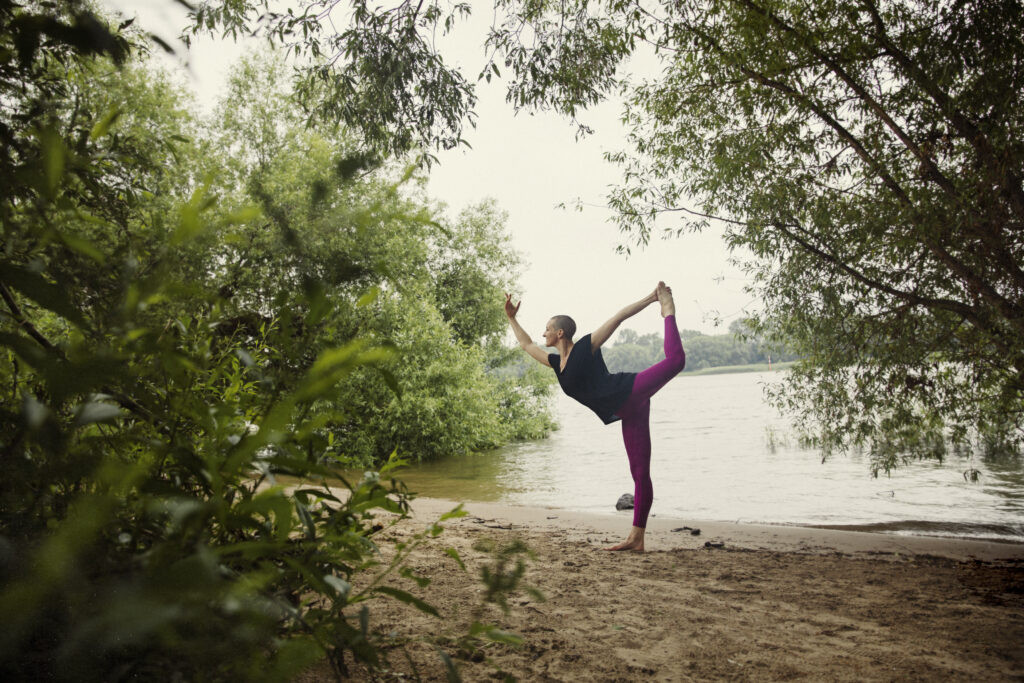 yoga poses dancer rhine river
yoga poses dancer rhine river
The Natarajasana, or King Dancer Pose, often simply called “Dancer Pose,” is more than just a beautiful posture; it’s a powerful yoga pose for dancers and yoga enthusiasts alike. This iconic and challenging pose is a journey into discovering your inner strength and grace. Inspired by the dynamic dance of Shiva Nataraja, the pose embodies courage and compassion, inviting you to explore the depths of your balance and flexibility.
Shiva Nataraja, the Lord of Dance, is traditionally depicted in a vibrant dance, standing upon a symbolic figure of ignorance. Cobras adorn his form, dreadlocks swirl around his head, and a ring of fire surrounds him, representing the cosmic dance of creation and destruction. Dancer Pose mirrors this dynamic imagery, asking us to find balance on one leg while gracefully extending the other, mirroring Shiva’s powerful yet poised stance.
This standing balancing pose, where one leg extends behind, grasped by the hand as you lean forward, can be both exhilarating and demanding. It challenges your physical limits while fostering mental focus and emotional resilience. Whether you’re a seasoned yogi or a dancer looking to enhance your practice, understanding the nuances of Dancer Pose can unlock a new dimension of strength and fluidity. Today, we’ll explore variations and modifications to make Dancer Pose accessible and beneficial for everyone, helping you experience its full potential.
Practice Mindfully and with Caution
Before attempting Dancer Pose or any of its variations, it’s crucial to approach with mindfulness and respect for your body’s limits. Remember, I am not a medical professional; I am sharing insights based on my experience and recommendations from trusted yoga experts. Always consult with your healthcare provider to address any health concerns and determine if yoga is suitable for you.
Mark Stephens, in Teaching Yoga, highlights the key physical considerations for Natarajasana, noting risks to the “Lower back, hamstrings and knee of the standing leg, shoulders if unstable or impinging.” (Teaching Yoga Location 4,091). Therefore, proceed slowly, paying close attention to your body’s signals and respecting any sensations that arise.
Step-by-Step Guide to Natarajasana
Jessamyn Stanley, in Every Body Yoga: Let Go of Fear, Get On the Mat, Love Your Body, emphasizes that Dancer Pose can be adapted for all levels, with both supported and unsupported variations. Stanley suggests using a strap as a helpful prop: “Optional Prop: 1 strap (make a loop with your strap that’s big enough to hold your foot)” (Every Body Yoga Location 1,092). If a yoga strap isn’t available, alternatives like a belt, dog leash, or towel can serve the same purpose. For added stability, especially when learning, utilize a wall or a sturdy chair for balance support.
Here are Stanley’s steps for entering Dancer Pose:
- “Starting in Mountain Pose, place your right hand on your hip for balance and bend your left knee.
- Clasp the inside or outside of your left foot with your left hand and, using the power of your leg muscles, begin lifting your thigh.
- If using a strap, hold the strap in your left hand. With your right hand on your hip for balance, bend your left knee and place your foot into the strap. Hold the strap as close to your foot as you comfortably can.
- Keep squaring your hips forward and lifting your thigh away from the floor, actively flexing your foot into the hand or strap.
- Sweep your right arm forward and up, reaching through your fingers and still continuing to lift your thigh.
- Draw your standing thigh back and soften your heart forward. Stay for a few breaths, then switch sides.” (Every Body Yoga Location: 1,094-1,102)
Stanley offers valuable tips for refining the pose, accompanied by visual aids demonstrating variations with and without a strap. Key pointers include: “Keep your hips even and neutral,” “actively press your foot into your hand or strap,” “keep a bend in your standing knee if necessary,” “press your tailbone to the floor while actively lifting your pubic bone toward your navel,” and “if you are holding on to a strap, if you have the flexibility, rotate your shoulder so that your bent elbow points to the ceiling.”
Mark Stephens provides slightly different instructional cues in Teaching Yoga: Essential Foundations and Techniques: “From Tadasana, flex the right knee to draw the right foot up toward the right hip. Clasping the right foot with the right hand, rotate the right elbow in and up while extending the right leg back and up from the hip. Lift the left arm overhead, bend the left elbow, and clasp the right foot.” (Teaching Yoga Location 4,093-5).
Stephens emphasizes key engagement points for both yoga instructors and students: “Maintain pada bandha [connection of the sole of the foot to the floor] in the standing foot to help stabilize the foot and ankle joint. Keep the standing leg straight and strong while aware of the tendency to lock the standing knee. Try to keep the pelvis level to create a symmetrical foundation for the full extension of the spine. Pressing the tailbone back and down, expand the chest, pressing the lower tips of the shoulder blades forward and up to open the heart center. If stable and at ease, release the crown of the head toward the arch of the foot and draw the elbows together. Breathe!” (Teaching Yoga Location 4,096-9). These cues highlight the importance of grounding, stability, and mindful expansion in Dancer Pose.
Dancer Pose Variations and Modifications
To make Dancer Pose accessible and adaptable, explore these variations. My 35-minute yoga flow on YouTube offers a guided practice through these modifications:
This video includes lower-level variations of Dancer Pose, balancing on two points (one arm and one leg/knee), both on the side and in a twisted form.
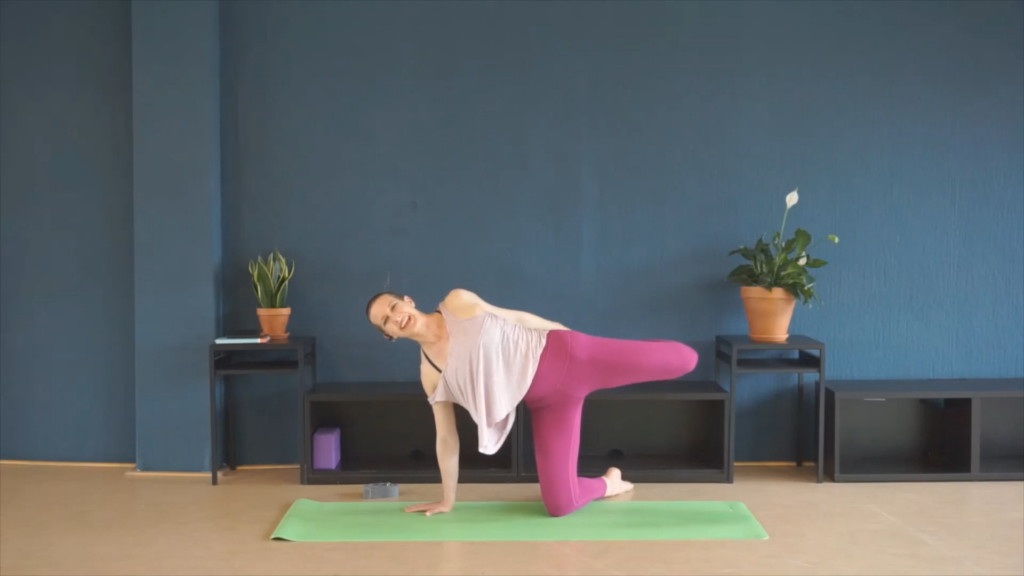 yoga poses dancer low side
yoga poses dancer low side
This variation, “Low Side Dancer,” offers a similar stretch and balance challenge to the traditional standing Natarajasana but from a different angle. A strap can also be used here for support.
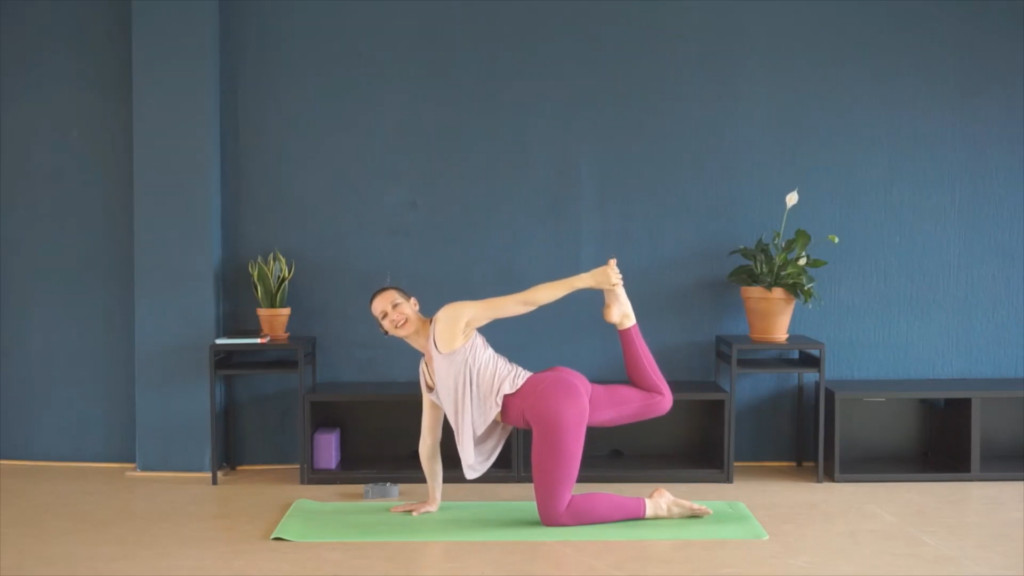 yoga poses dancer low twisted
yoga poses dancer low twisted
“Low Twisted Dancer” presents a slightly different stretch and balance challenge, adding a gentle twist to engage core muscles. Again, a strap can be incorporated for assistance.
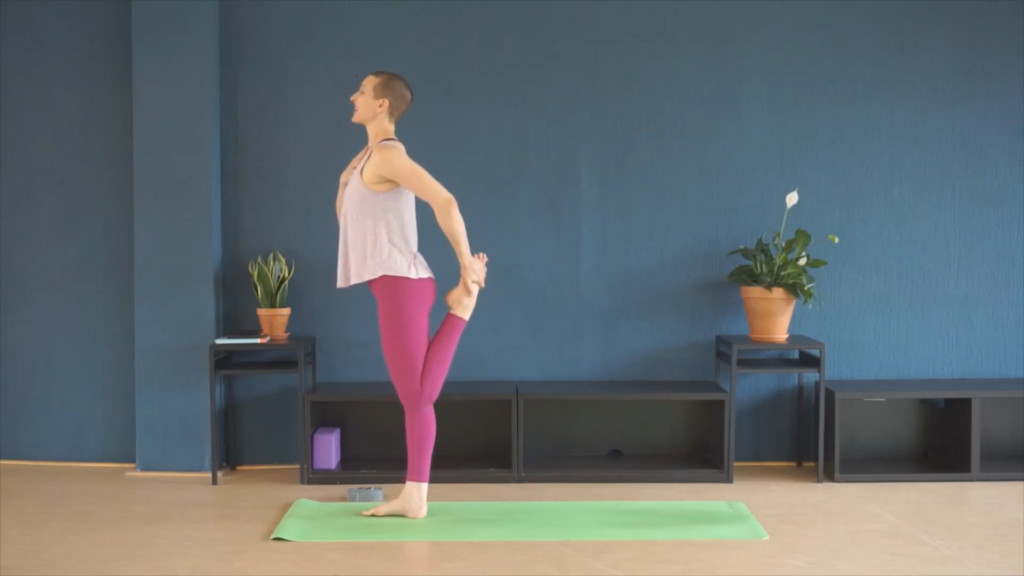 yoga poses dancer hand heart quad
yoga poses dancer hand heart quad
This position can serve as a preparatory stage for standing Dancer Pose or as a modification itself. It helps develop one-legged balance, promotes heart opening, and stretches the quadriceps, offering a gentle backbend. A strap and/or wall can be used for support.
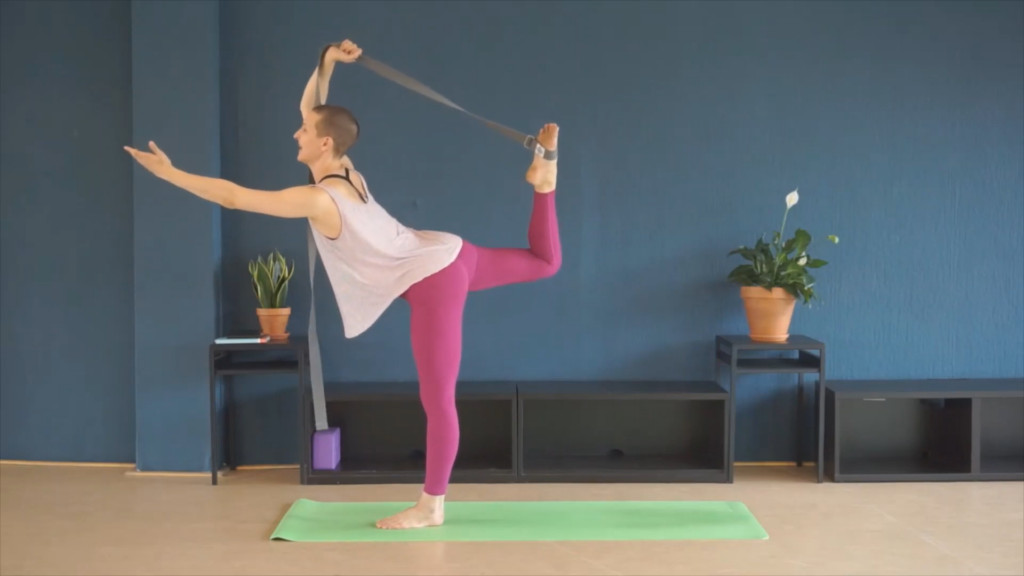 yoga poses dancer with strap
yoga poses dancer with strap
Practicing standing Dancer Pose with a yoga strap is an excellent way to build confidence and deepen the stretch. Remember, utilizing a wall for support is always an option. Consider varying your gaze and hand positions (mudras) to further personalize your Dancer Pose practice. The possibilities for variations and modifications are endless, allowing you to tailor Dancer Pose to your unique needs and abilities.
The Mythology of Natarajasana
Understanding the story behind Natarajasana adds a layer of depth to your practice. In Myths of the Asanas: The Stories at the Heart of the Yoga Tradition, Alanna Kaivalya, Shiva Rea, and Manorama explain that Nataraja is one of Shiva’s many forms, representing the Master Dancer and the destroyer of cycles, eternally dancing to the rhythm of his drum, paving the way for new creation by Brahma.
Key aspects of this myth to consider are Shiva as the King Dancer, the concept of Samsara, and the illusion of Avidya. Kaivalya and Rea elaborate, “As one of the Hindu trinity, Shiva has many different personae that illuminate his essence. The most well known is his role as the King Dancer, or in Sanskrit, Nataraja. In this guise he is commonly portrayed with snakes around his neck, dreadlocks standing on end, balancing atop a tiny dwarf, and encircled by a ring of fire.” (Myths of the Asanas Location: 537-539).
The ring of fire surrounding Nataraj symbolizes samsara, the cycle of life, death, and rebirth, “Shiva dances to his own music within a circle of flame known as samsara. Samsara is the cyclical pattern in which we are all stuck—the constant repetition of birth, life, and death.” (Myths of the Asanas Location: 544-5).
The cobras around Nataraj’s neck represent avidya, the misunderstanding of our true nature. “The poison the cobra carries symbolizes the toxic nature of avidya, the misunderstanding of ourselves as something other than divine. He has found the remedy to that affliction, which is enlightened knowledge, and he carries its symbolic flame in one of his palms.” (Myths of the Asanas Location: 550-1 emphasis mine). Thus, Dancer Pose becomes not just a physical posture but a symbolic representation of overcoming ignorance and embracing divine knowledge.
Lessons from Dancer Pose for Dancers and Life
What can we learn from Dancer Pose, both as dancers seeking to refine our art and as individuals navigating life’s journey?
Kaivalya and Rea offer insights into the psychological dimensions of Dancer Pose: “Natarajasana allows us to experience a couple of physical elements that can bring about fear in our bodies. Backbending and balancing both elicit fear because of the openness and bravery they require. We tend to store fear in our heart (according to the chakra system), and when we open the heart, we give ourselves an opportunity to let go of fear. Likewise, balancing gives us an opportunity to overcome our natural fear of falling and to be brave and free.” (Myths of the Asanas Location: 576-8).
Dancer Pose confronts us with two core fears: losing balance and vulnerability through backbending. In yoga practice, we often address these elements separately, gradually expanding our comfort zones. We cultivate stability, balance, and flexibility in key areas like hips, back, and shoulders. Practices like tree pose for balance, and camel or wheel pose for backbending prepare us for the integrated challenge of Dancer Pose.
It’s a common misconception that dancers, with their inherent flexibility, effortlessly master Dancer Pose. However, it presents unique challenges for everyone. Personal limitations, like lower back stiffness or past injuries, require mindful preparation and practice. The fear of balancing and backbending is universal, reminding us that everyone faces their own set of obstacles and strengths in yoga.
Dancer Pose offers significant benefits for dancers and athletes, both physically and mentally. The courage to attempt and refine this pose is commendable. The myth of Nataraja and the experience of practicing Dancer Pose teach us to confront fears, embrace change, and release attachments, ultimately leading to self-discovery and a deeper understanding of our place in the universe.
Spiritual Benefits of Dancer Pose Practice
On a spiritual level, Dancer Pose introduces us to concepts like avidya and abhinivesha. Kaivalya and Rea explain, “In the Yoga Sutra, Patanjali outlines five obstacles that prevent us from true freedom, which are called the kleshas. The first is avidya, and the fifth and most powerful obstacle is the fear of death, or abhinivesha. Death is the ultimate change and takes many forms in our lives, until the greatest death of all, which comes at the end. As the lord of death and destruction, Shiva understands that change, even one as great as death, is really the only constant in the universe.” (Myths of the Asanas Location: 566-7).
Navigating change is a crucial life skill that yoga, especially poses like Dancer, cultivates. This process is deeply rooted in self-awareness and self-knowledge, fostered through compassionate self-study via reflective practice and meditation. Dianne Bondy and Kat Heagberg in Yoga Where You Are, emphasize the power of compassionate self-study: “Compassionate self-study offers a path to meet yourself without judgement, just where you are and just how you are.” (p.212).
Compassionate self-study happens in moments of meditation, journaling, and mindful yoga practice. For further exploration of reflective practices, consider reading my article on Reflective Practice through Journaling in Dance, Yoga & Life. To begin a meditation journey, my 2021 Meditation Practice Challenge blog offers guidance.
Ultimately, the practice of Dancer Pose guides us toward greater freedom: freedom of movement, courage to face life’s uncertainties, and compassion for ourselves and others.
“In order to dance like Shiva, we must feel free. Freedom comes from knowing there is nothing that binds us permanently. Shiva’s dance is born out of a liberation from the fear of change. He teaches us to ride the wave of change as if we’re on a cosmic surfboard, coasting toward the shore of bliss.” (Myths of the Asanas Location: 564-5).
Reflective Questions
Consider these questions to deepen your understanding and practice of Dancer Pose:
- What challenges do you encounter in Dancer Pose?
- Which modifications or variations help you access the pose more fully?
- What other yoga poses or movements do you generally find challenging?
- What emotions surface for you during these challenging moments?
- How can modifications or variations help you unlock the benefits of these poses or activities?
- How can I or another trusted instructor support your yoga journey?
Blythe Stephens, MFA & Bliss Catalyst
she/her or they/them
A Blythe Coach: Dance Education & Coaching – move through life with balance, grace, & power
DISCLAIMER: A Blythe Coach recommends consulting your physician before starting any exercise program and following all safety instructions. Exercise involves risks of physical injury. By participating, you assume all risks and voluntarily engage in these activities.
